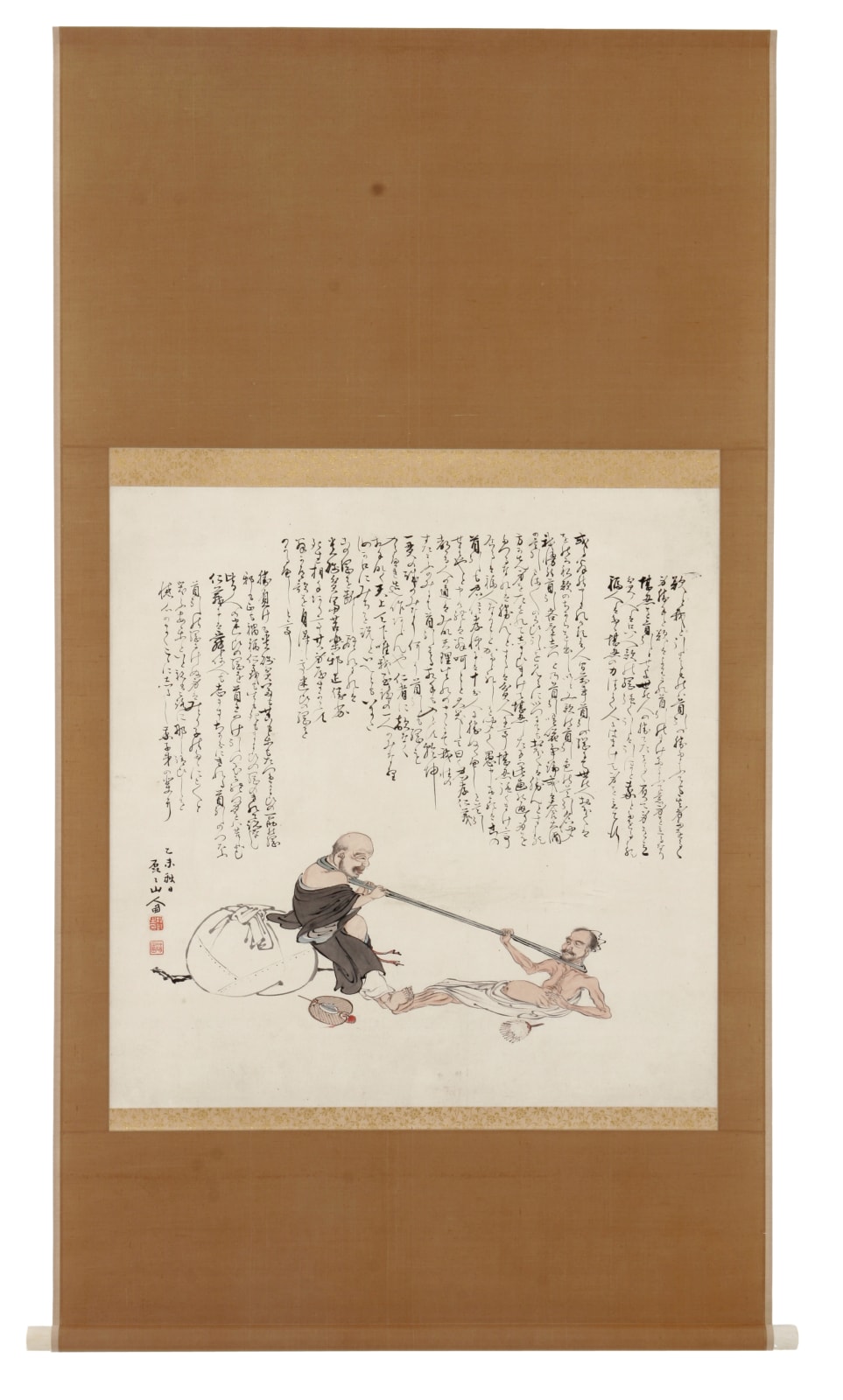Matsuzaka Saiho 松坂菜圃
Neck-Pulling Game between Hotei and a Sennin, dated autumn of 1895
Image Size 26½ x 26¼ in. (67.8 x 66.5 cm)
Overall Size 56¾ x 31 in. (144 x 79 cm)
Overall Size 56¾ x 31 in. (144 x 79 cm)
T-1498
Hotei testing his power against an old hermit, painting in ink and colors on paper. The extensive inscription describeds a kubihiki contest between Hotel and a Chinese Sennin: humorous text...
Hotei testing his power against an old hermit, painting in ink and colors on paper. The extensive inscription describeds a kubihiki contest between Hotel and a Chinese Sennin: humorous text with reference to the contest, to drinking large amounts of sake, and so on. Signed: “Painted by Rairai Sanjin” 磊々山人画
Seals: 1) “The seal of Matsuzaka” 松坂之印 and 2) Saiho 菜圃
Artist names used by Matsuzaka Saiho: Ken 謙, Kenji 謙治, Unseki 雲石, and Rairai Sanjin 磊々山人
References:
Hiramatsu Kanji 平松勘治. Nagasaki yûgakusha jiten 長崎遊学者事典.
Keisuisha 渓水社, 1999 松坂菜圃; 別名: 謙,謙治,雲石,磊々山人 Signed: “Painted by Rairai Sanjin” 磊々山人画
Seals: 1) “The seal of Matsuzaka” 松坂之印 2) Saiho 菜圃
Artist names used by Matsuzaka Saiho include: Ken 謙, Kenji 謙治, Unseki 雲石, and Rairai Sanjin 磊々山人
Biography:
Matsuzaka Saiho was born in Sendai and showed early promise as a painter. He was first taught by Kakizaki Shinsai 蠣崎縉齊 (1785-1863), a leading early modern Sendai painters, who was a Shijô painter stemming from the Iwate prefecture.
Later the artist traveled to Nagasaki, where he was taught by the famous Zen abbot and painter, Tetsuô Somon 鉄翁祖門 (1791-1872), a Nanga painter who specialized in ink paintings of orchids and bamboo.
Saiho traveled wide in Japan and left his paintings at a number of places. He was noted for his Chinese themes, as can be seen in this painting of a neck-pulling contest between Hotei and a Chinese sage.
References:
Hiramatsu Kanji 平松勘治. Nagasaki yûgakusha jiten 長崎遊学者事典.
Keisuisha 渓水社, 1999, 13
Kikuta Sadasato 菊田定郷. Sendai jinmei daijisho 仙台人名大辞書. Tokyo: Rekishi Toshosha 歴史図書社, 1974
Ōbayashi Akio 大林昭雄. Sendai gajinden 仙台画人伝. Sendai: Gyararī Ōbayashi ギャラリー大林, 1991
Seals: 1) “The seal of Matsuzaka” 松坂之印 and 2) Saiho 菜圃
Artist names used by Matsuzaka Saiho: Ken 謙, Kenji 謙治, Unseki 雲石, and Rairai Sanjin 磊々山人
References:
Hiramatsu Kanji 平松勘治. Nagasaki yûgakusha jiten 長崎遊学者事典.
Keisuisha 渓水社, 1999 松坂菜圃; 別名: 謙,謙治,雲石,磊々山人 Signed: “Painted by Rairai Sanjin” 磊々山人画
Seals: 1) “The seal of Matsuzaka” 松坂之印 2) Saiho 菜圃
Artist names used by Matsuzaka Saiho include: Ken 謙, Kenji 謙治, Unseki 雲石, and Rairai Sanjin 磊々山人
Biography:
Matsuzaka Saiho was born in Sendai and showed early promise as a painter. He was first taught by Kakizaki Shinsai 蠣崎縉齊 (1785-1863), a leading early modern Sendai painters, who was a Shijô painter stemming from the Iwate prefecture.
Later the artist traveled to Nagasaki, where he was taught by the famous Zen abbot and painter, Tetsuô Somon 鉄翁祖門 (1791-1872), a Nanga painter who specialized in ink paintings of orchids and bamboo.
Saiho traveled wide in Japan and left his paintings at a number of places. He was noted for his Chinese themes, as can be seen in this painting of a neck-pulling contest between Hotei and a Chinese sage.
References:
Hiramatsu Kanji 平松勘治. Nagasaki yûgakusha jiten 長崎遊学者事典.
Keisuisha 渓水社, 1999, 13
Kikuta Sadasato 菊田定郷. Sendai jinmei daijisho 仙台人名大辞書. Tokyo: Rekishi Toshosha 歴史図書社, 1974
Ōbayashi Akio 大林昭雄. Sendai gajinden 仙台画人伝. Sendai: Gyararī Ōbayashi ギャラリー大林, 1991
34
of
34
